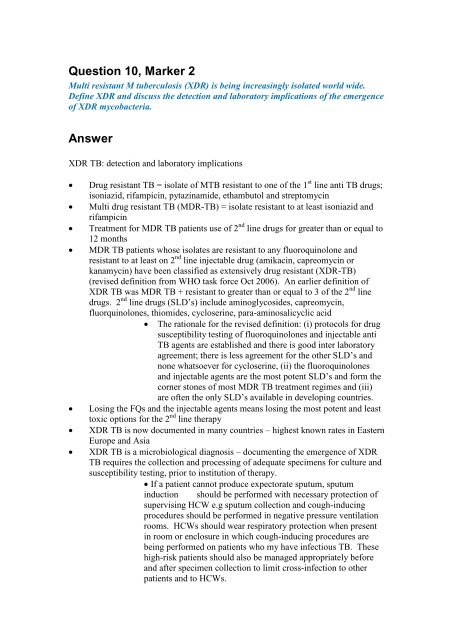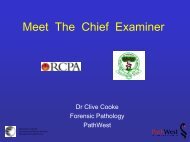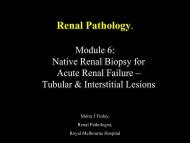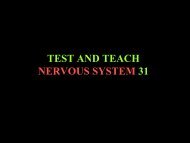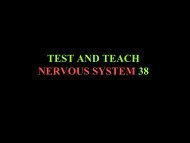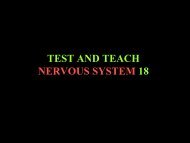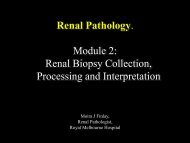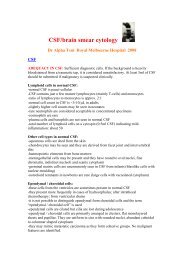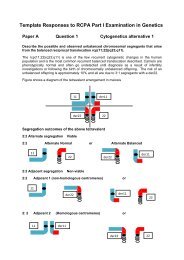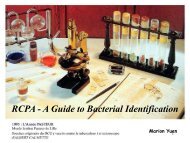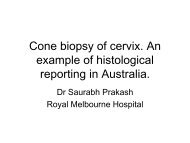Model Answers Microbiology Written examinations 2007 - RCPA
Model Answers Microbiology Written examinations 2007 - RCPA
Model Answers Microbiology Written examinations 2007 - RCPA
You also want an ePaper? Increase the reach of your titles
YUMPU automatically turns print PDFs into web optimized ePapers that Google loves.
Question 10, Marker 2<br />
Multi resistant M tuberculosis (XDR) is being increasingly isolated world wide.<br />
Define XDR and discuss the detection and laboratory implications of the emergence<br />
of XDR mycobacteria.<br />
Answer<br />
XDR TB: detection and laboratory implications<br />
<br />
<br />
<br />
<br />
<br />
<br />
<br />
Drug resistant TB = isolate of MTB resistant to one of the 1 st line anti TB drugs;<br />
isoniazid, rifampicin, pytazinamide, ethambutol and streptomycin<br />
Multi drug resistant TB (MDR-TB) = isolate resistant to at least isoniazid and<br />
rifampicin<br />
Treatment for MDR TB patients use of 2 nd line drugs for greater than or equal to<br />
12 months<br />
MDR TB patients whose isolates are resistant to any fluoroquinolone and<br />
resistant to at least on 2 nd line injectable drug (amikacin, capreomycin or<br />
kanamycin) have been classified as extensively drug resistant (XDR-TB)<br />
(revised definition from WHO task force Oct 2006). An earlier definition of<br />
XDR TB was MDR TB + resistant to greater than or equal to 3 of the 2 nd line<br />
drugs. 2 nd line drugs (SLD‟s) include aminoglycosides, capreomycin,<br />
fluorquinolones, thiomides, cycloserine, para-aminosalicyclic acid<br />
The rationale for the revised definition: (i) protocols for drug<br />
susceptibility testing of fluoroquinolones and injectable anti<br />
TB agents are established and there is good inter laboratory<br />
agreement; there is less agreement for the other SLD‟s and<br />
none whatsoever for cycloserine, (ii) the fluoroquinolones<br />
and injectable agents are the most potent SLD‟s and form the<br />
corner stones of most MDR TB treatment regimes and (iii)<br />
are often the only SLD‟s available in developing countries.<br />
Losing the FQs and the injectable agents means losing the most potent and least<br />
toxic options for the 2 nd line therapy<br />
XDR TB is now documented in many countries – highest known rates in Eastern<br />
Europe and Asia<br />
XDR TB is a microbiological diagnosis – documenting the emergence of XDR<br />
TB requires the collection and processing of adequate specimens for culture and<br />
susceptibility testing, prior to institution of therapy.<br />
If a patient cannot produce expectorate sputum, sputum<br />
induction should be performed with necessary protection of<br />
supervising HCW e.g sputum collection and cough-inducing<br />
procedures should be performed in negative pressure ventilation<br />
rooms. HCWs should wear respiratory protection when present<br />
in room or enclosure in which cough-inducing procedures are<br />
being performed on patients who my have infectious TB. These<br />
high-risk patients should also be managed appropriately before<br />
and after specimen collection to limit cross-infection to other<br />
patients and to HCWs.


